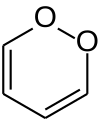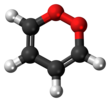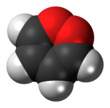1,2-Dioxin
Appearance

| |||
| |||
| Names | |||
|---|---|---|---|
| Systematic IUPAC name
1,2-Dioxine[1] | |||
| Identifiers | |||
3D model (JSmol)
|
|||
| ChemSpider | |||
PubChem CID
|
|||
CompTox Dashboard (EPA)
|
|||
| |||
| |||
| Properties | |||
| C4H4O2 | |||
| Molar mass | 84.074 g·mol−1 | ||
| Related compounds | |||
Related compounds
|
Dibenzodioxin | ||
Except where otherwise noted, data are given for materials in their standard state (at 25 °C [77 °F], 100 kPa).
| |||
1,2-Dioxin is a heterocyclic, organic, antiaromatic compound with the chemical formula C4H4O2. It is an isomeric form of 1,4-dioxin (or p-dioxin).
Due to its peroxide-like characteristics, 1,2-dioxin is very unstable and has not been isolated. Even substituted derivatives are very labile, e.g. 1,4-diphenyl-2,3-benzodioxin.[2] Indeed, in 1990, 3,6-bis(p-tolyl)-1,2-dioxin was wrongly accounted as the first stable derivative.[3] It was subsequently shown that the initial compound was not a derivative of 1,2-dioxin, but a thermodynamically more stable dione.[4]
-
The isomers 1,2-dioxin (left) and 1,4-dioxin (right)
-
Structure of the transient 1,4-diphenyl- 2,3-benzodioxin
-
Dioxin (1) and dione form (2)
References
- ^ "CID 15559065 - Compound Summary". PubChem Compound. USA: National Center for Biotechnology Information. 12 February 2002. Identification and Related Records. Retrieved 7 October 2011.
- ^ J. P. Smith, A. K. Schrock, G. B. Schuster: Chemiluminescence of organic peroxides. Thermal generation of an o-xylylene peroxide, J. Am. Chem. Soc., 1981, 104, 1041–1047; doi:10.1021/ja00368a021.
- ^ H. J. Shine, D. C. Zhao: Electron transfer to excited doublet states. Photoirradiation of 10-methylphenothiazine cation radical perchlorate in solutions of phenylacetylene and p-tolylacetylene in acetonitrile, J. Org. Chem., 1990, 55, 4086–4089; doi:10.1021/jo00300a026.
- ^ E. Block, Z. Shan, R. S. Glass, J. Fabian: Revised structure of a purported 1,2-dioxin: a combined experimental and theoretical study, J. Org. Chem., 2003, 68, 4108–4111; PMID 12737603; doi:10.1021/jo034305i.





